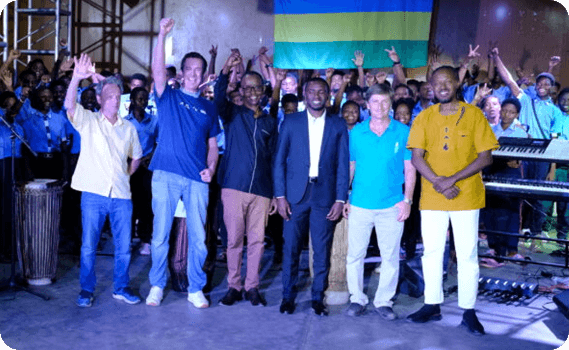Telemidi - The Next Step in Remote Creativity
Telemidi acts at the forefront of remote collaboration. Backed by cutting edge PhD research, Telemidi overcomes the impact of latencies inherent when sharing real-time data online.
Telemidi’s innovative approaches allow for the synchronisation of musical actions across remote locations. This provides collaborators with a convincing sense of telepresence, the feeling of sharing a creative space, even if worlds apart.
Telemidi was created with music performance in mind, however the potential applications relate to any scenario where music provides value to the end user; including entertainment, education, online gaming, medical therapeutics, wellness, and entirely new frontiers of human creative expression; Telemidi unlocks the potential of what is possible.


What is Telemidi
Telemidi operates within the new paradigm of Telematic Music Performance (TMP), defined by the exchange of musical ideas over significant distances via technology. Following the formats of the telegraph, telephone and television, Telemidi transmits MIDI (Musical Instrument Digital Interface) data over the Internet, where the identical music performance actions are shared between remote locations wiithin the blink of an eye or less. MIDI (1983) is an original digital protocol, a ubiquitous platform found in all computer operating systems and music studios, and has enabled the coordination of synthesisers, sequencers and computer software in popular music and EDM genres for over forty years.
TMP first emerged in the late 1960’s as ISDN telephone networks first appeared, but has sat at the perimeter of artistic and academic ventures for decades, due largely to the obstruction and negative influence of latency delays which swiftly degrade musical cooperation. Despite a growing prevalence of the Internet for streaming music files, the sharing of real-time music data online disrupts coordination and rhythmic syncopation, to cause confusion for musicians attempting to lock in with each other; to create, groove and make music online.
Recent history has delivered an exponential evolution for musical technologies; from the phonograph, to amplification, radio broadcasting, multi-track recording, CDs, computer music software, P2P file sharing, streaming services and even AI music. Each technology brings with it both new affordances and limitations. The digital revolution has provided modern musicians with tools for astonishing accuracy and manipulation in music production, however, latency has been the price to pay for this computational majesty.
Fortunately, Matt Bray’s PhD research revealed novel approaches in Latency Accepting Solutions (LAS), network architecture design, and the use of MIDI controller instruments, to enhance musical synchronicity among remote collaborators.
The Latency Accepting Solutions (LAS) deal with the presence of latency, and find ways to incorporate it into the music making process so that performers may overcome its limitations. Thereby musicians may freely exchange ideas on the fly, and develop songs by improvising with pre-curated sounds, motifs and foundational rhythmic patterns to surpass latency, regardless of the distance between users.

Key Features and Benefits
Low Latency Connections
The Telemidi Protocol software (patent pending) minimises latency times between remote performers.
Automating Remote Servers
Regardless of your location, when two clients start a Telemidi session, the most suitable remote server is established and automated to provide the lowest latency possible.
Zero-Latency performance feed to audiences
The Telemidi Protocol software (patent pending) allows for the complete re-sequencing of all performance actions, so that the audience experiences all music actions, as played, in a matter of milliseconds.
Multi-Media MIDI data
Every musical performance action can be harnessed to generate immersive VR visuals. This serves education and entertainment, blending artistic expression and engagement.
Real-time Synchronisation Across Remote DAWs
The Telemidi Protocol software (patent pending) synchronises the operation of remote, networked computers running music software (also known as Digital Audio Workstations (DAWs)). As each participant listens to the high resolution audio output and stable tempo of their own DAW, the Telemidi Protocol ensures that all DAWs in the collaboration are coordinated to function within 5msec of each other. This allows musicians to connect, simultaneously collaborate, and share MIDI data that accommodates a full suite of musical actions, is 100% reliable, and is significantly reduced in its exposure to network latency.
Advanced Connectivity for a Range of Applications
The connectivity provided by the Telemidi Protocol software can be customised to adapt to various use cases, dependent on the required purpose of collaboration, the number of participants involved, and the styles of music to be created. This is possible because the Telemidi Protocol is complimented by the latest technologies in cloud computing, to provide highly efficient and automated network architectures that simplify connectivity and user engagement. Whether the live music is from a solo performer, a duo, trio, or up to hundreds of networked performers, and the purpose being for education, medical therapeutics or music performances, the Telemidi infrastructures are immensly flexible and accommodating.
Enhanced Telepresence
By aligning networked DAW activity to within 5msec, by automating the most efficient network architectures, and by employing innovative LAS, Telemidi enables users to engage in shared musical actions with their remote peers such that they become unaware of the distances between them. Telemidi users gain an experience of enhanced telepresence, the feeling that they are sharing the same creative space as their collaborator, no matter how far apart they may be. This feeling of shared space promotes a more sincere connection, where ideas flow more readily, to be received and reciprocated with increased enthusiasm and flair.
Immersive Visual Environments
In the digital world, all information is reduced to binary code, a sequence of ones and zeros that underpin all data, communications, activity, images and sounds etc. MIDI is exceptional at capturing musical performance actions, alongside control and operational commands, all of which exist as simple binary code sequences. This binary data can easily be applied to generate non-musical outcomes, such as visual graphics that can be viewed by audiences. Matt Bray’s PhD research demonstrated how a musical note pressed at one location, can generate any manner of graphic outcomes to be viewed within immersive environments when using VR headwear. This has significant ramifications for education, online gaming, medical therapeutics, wellness, and for any online audience of Telemidi events.
Applications
Music
First and foremost, Telemidi was designed to revolutionise remote musical collaboration in real-time, by enabling the exchange of musical ideas in the form of MIDI data. The core sub-structures of music are defined by Telemidi as beats, bass, harmony, melody and effects, and collaborators assume various roles and complimentary engagements within this format to generatively build song structures, perform motifs and improvise together. This could be in the format of two or more individuals using smart phone applications to connect, two DJs playing Back-to-Back (B2B) from different cities, a laptop orchestra playing online, or any combination of musicians connecting to the Internet.
Education
By using visual outcomes from musical actions, Telemidi enhances education via the instant visual feedback on notes played, score notation, rhythmic patterns and harmonic information etc. When coupled with AI machine learning that monitors the ms timestamps of each user’s actions, there is scope to intimately diagnose a user’s skill sets, and to specifically tailor lessons. Further, novice musicians engage immediately with the Telemidi platform to create music with a skill-matched peer via a gamified interface, this significantly reduces barriers to learn music theory. Learning through play, and collaborating with remote peers of a similar skill level, creates a new platform for budding musicians to learn via bespoke lessons. Students can interact and learn together fluidly no matter where they are situated.
Online Gaming Environments
Legacy games such as Guitar Hero are catapulted into a new dimension by Telemidi, by allowing remote collaborators to interact simultaneously. Similar Vertical Scrolling Rhythm Games (VSRG), have been immensely popular for both engagement and competition, and Telemidi enables these to feature remote collaboration. Major gaming companies have begun exploring this space but are limited by the obstruction of latency, a situation that the Telemidi Protocol can overcome. Telemidi also holds great potential for use in theatrical, abstract art installations, and VR/AR applications.
Music Therapy
Healthcare initiatives such as music therapy, audiology testing, telehealth services and other medical therapeutics, are enhanced for remote practice by Telemidi. This is due to secure, low latency connections, and the subsequent msec detail drawn from metrics related to a patient’s response times, pitch recognition, pattern repetition, sound selection etc., alongside an array of expressive actions that can be presented as multi-media artefacts. The telepresence offered by Telemidi networks, ensure that sessions remain authentic, trusted and reliable, even if separated by far distances to foster a stronger doctor-patient bond.
Online Wellness
As conversations around mental health in the digital space increase, Telemidi offers the capacity for live music performance to be engaged by users within online wellness spaces. Whether its in a corporate breakout room providing guided mediation that features live music performance, or for team building collaborations offering creative musical engagement, or for activating artistic, human-to-human creativity for those located in remote communities; Telemidi provides the essential option of involving the performance of live music. Academic research reveals the benefits felt by participants when exposed to the live performance of music in a socially connected environment.

Get Involved
Telemidi redefines remote collaboration through cutting-edge solutions.
Explore our API and technical resources to understand how Telemidi can be integrated into your projects. Or, sign up to our newsletter to stay at the forefront of our innovations.